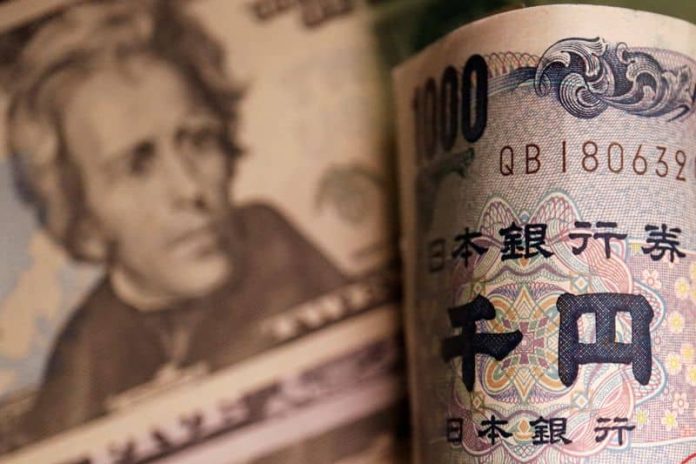By Ankur Banerjee
SINGAPORE (Reuters) – The U.S. dollar eased from a two-month peak on Wednesday as investors looked to the Federal Reserve chair’s speech this week for cues on the path of monetary policy, while the yen loitered near 146 a dollar, keeping traders guessing on any intervention.
The dollar index, which measures the U.S. currency against six rivals, fell 0.145% to 103.44, but was not far from the two-month high of 103.71 it touched on Tuesday. The index is up 1.6% in August, on course to snap a two-month losing streak.
The currency market is subdued amid a lull in summer volatility and ahead of the Fed’s central bank symposium at Jackson Hole, Wyoming, this week, said currency strategist Christopher Wong at OCBC in Singapore.
With traders reluctant to place major bets, the spotlight is firmly on Fed Chair Jerome Powell’s speech at the event, which is set for Aug. 24-26. Investors will parse his words closely to gauge the Fed’s monetary policy path.
A recent run of strong U.S. economic data has helped allay worries of an impending recession but with inflation still well above the Fed’s target of 2%, investors are wary that the central bank may keep rates in a higher range for longer.
“Markets are looking out for hints of earlier (policy) shifts or extensions of higher for longer,” said Wong.
Richmond Fed President Thomas Barkin said on Tuesday the Fed must be open to the possibility that the economy will begin to re-accelerate rather than slow, with potential implications for the U.S. central bank’s inflation fight.
Markets are pricing in an 86% chance of the Fed standing pat at its policy meeting next month, the CME FedWatch tool showed, but the odds of the U.S. central bank hiking interest rates one more time this year toward the end of the year have been rising.
The potential for additional hikes after a likely pause at its September meeting, combined with a decrease in excess savings, could weaken consumer momentum toward the end of the year, said Saira Malik, CIO at Nuveen.
Investors’ focus will be on the U.S., euro zone and UK August PMI data due later in the day.
The yen strengthened 0.12% to 145.71 per dollar in Asian hours but was not far off the nine-month milestone of 146.565 touched last week, leaving traders on tenterhooks as they warily watch for any signs of intervention.
When the dollar broke above 145 yen last year that triggered intervention, and speculation has begun mounting that Tokyo would soon step into the market to support its currency again.
Atsushi Takeuchi, who was head of the Bank of Japan’s foreign exchange division when Tokyo intervened in 2010-2012, said Japan will forgo intervening unless the yen moves past 150 and becomes a huge political headache for premier Fumio Kishida.
“Authorities usually don’t have a specific line-in-the-sand in mind. But key thresholds like 150 are important for political reasons, as they are easy to understand,” Takeuchi said.
Both this time and in 2022, currency intervention itself would not be a fundamental solution to the yen weakness but could only buy time, strategists at BofA Global Research said.
“The key difference is that while Japan did not have any control over the fundamental cause of the dollar-yen rally in 2022, it can to some extent decide until when to buy time in cooperation with the Bank of Japan because the BOJ controls the short-end of the yen yield curve”
Another Asian currency that has worried investors is China’ yuan, which is down over 5% this year against the dollar largely due to concerns over the country’s deepening property crisis, which is putting further downward pressure on China’s sputtering post-pandemic economic recovery.
The spot yuan opened at 7.2870 per dollar on Wednesday and was changing hands at 7.2807, 1.13% weaker than the midpoint, which was set at 7.1988 per U.S. dollar, over 1,000 pips stronger than market projections.
In other currencies, the euro up 0.15% to $1.086, inching away from the two-month low of $1.0833 it touched overnight.
The Australian dollar rose 0.23% to $0.644, while the New Zealand dollar inched up 0.08% to $0.595.
In cryptocurrencies, bitcoin last rose 0.7% to $26,030, having touched two-month low of $25,350 overnight.



















